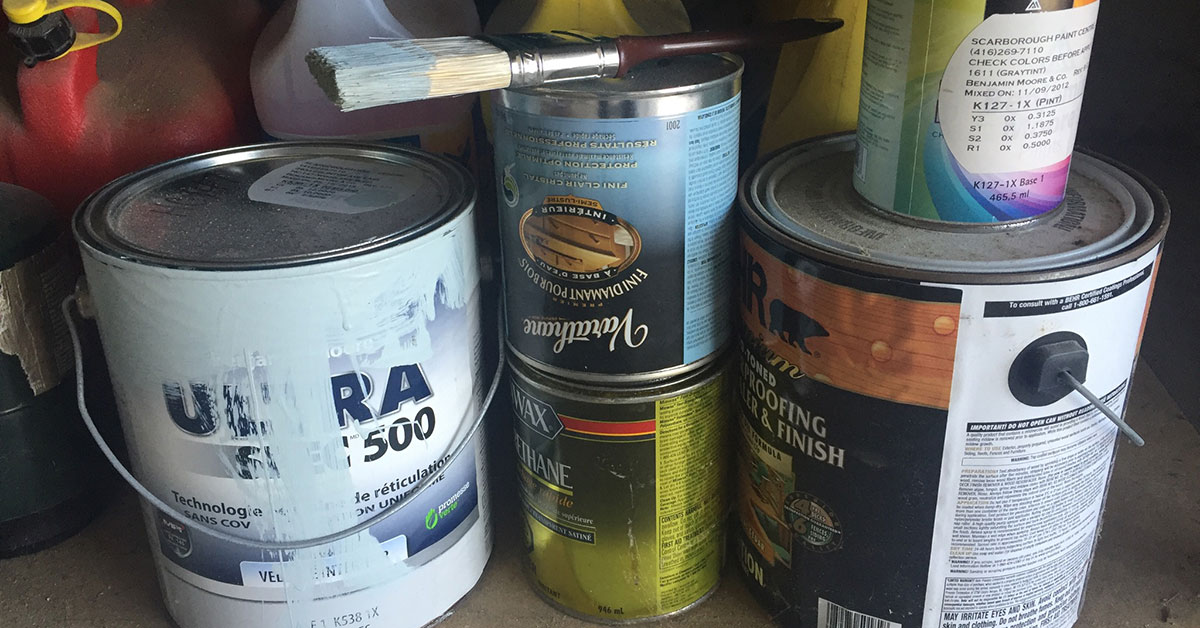
Starting a long-delayed garage junk cleaning project is the most meaningful step you can make towards reclaiming your garage’s functionality.
Cluttered garages severely limit the usefulness of this vital room in your home. Instead of using the garage for parking vehicles, efficient storage, and for things like working out or as a home workshop, stacked piles of unused junk rule the roost.
Essentially, a space that is capable of serving your family in many different ways becomes completely one-dimensional.
Why do we let junk take over our garages?
It’s a wonder that so many homeowners allow a collection of things that have little or no worth or significance (the literal definition of junk) dictate how they can use their garages.
There are millions of garages across the U.S. and Canada that are each clogged with junk that is maybe worth a few hundred dollars. Meanwhile, vehicles worth tens of thousands of dollars are left parked in driveways where they’re much less secure and exposed to the elements.
What’s wrong with this picture?
Messy garages make a quarter of homeowners embarrassed to leave their garage doors open, according to an Impulse Research survey. A Garage Living poll with 1,500 North American respondents found that 20% of homeowners were unable to park in their garage.
Maybe you’re considering a modestly budgeted makeover project that updates your garage’s décor and improves its storage efficiency. Perhaps a more elaborate remodel that results in a swanky luxury garage is what you’re planning.
In either case, the first step in transforming your space is to get that garage junk cleaning project in motion.
Follow this one rule with your garage junk cleaning project
When you start your garage junk cleaning project, figuring out what you need to get rid of should be obvious in many cases. That broken VCR, filthy old couch, and rusty garden tools, for example, are no-brainers.
But if you’re on the fence about whether or not to toss or donate anything, follow this one decluttering rule: have I used this item in the past one or two years?
Most organization professionals adhere to the “one year rule” with decluttering, as in get rid of anything that hasn’t been touched in the past year.
That may not work best for everything that gets stored in the garage, however. If you give yourself some leeway and stretch that out a bit to two years, the answer should be even clearer about what items actually get used and are truly worth keeping.
Finally dealing with your clutter and junk can pave the way towards creating a beautiful room in your home that goes well beyond what you ever thought was possible with a garage. Just look at the before and after garage makeover photos below for proof!
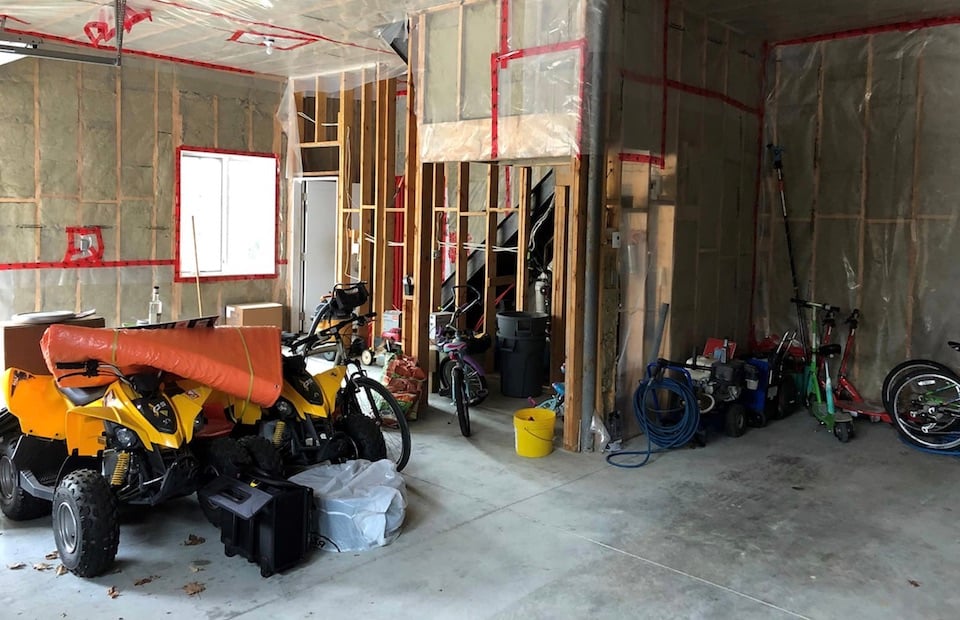
Prior to its makeover, this unfinished garage had floor clutter and lacked effective storage and organization systems.
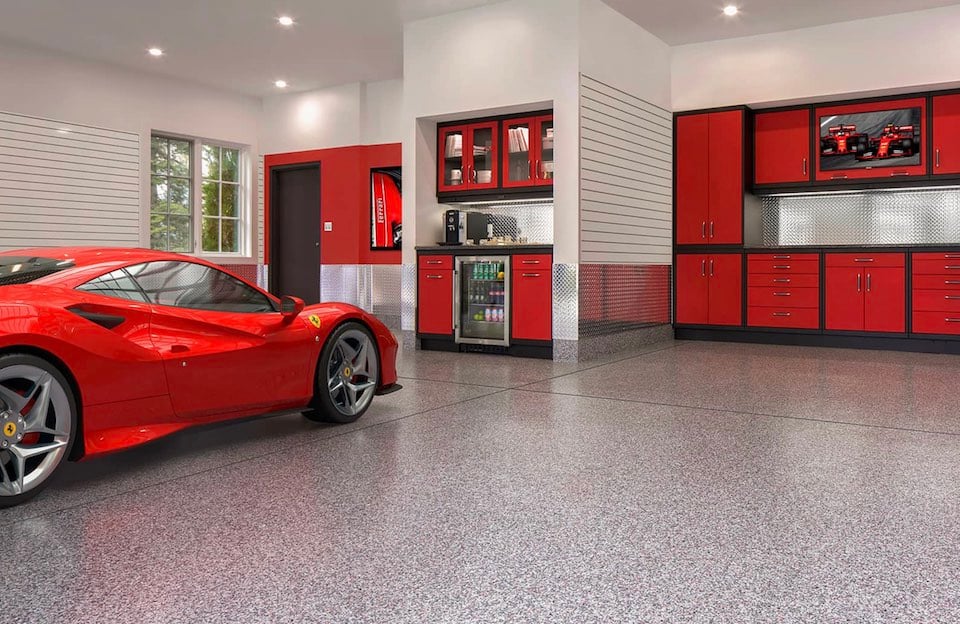
After the makeover, this clean, stylish, and tidy garage looks like a completely different room.
Get “all hands on deck” with your garage cleaning project
Get the whole family involved with your junk cleaning project. After all, they surely helped contribute to the accumulation of clutter in the room. They’ll benefit when the garage is in better organizational shape, too.
If you have the space in your garage or if the weather allows for organizing things in your driveway, establish a junk and clutter staging area where you can group the things you’ll be throwing out or donating.
As you proceed, you should find that these 15 common types of garage junk and clutter will make up the bulk of what you’ll be getting rid of.
1. Old paint
Most garages that would be considered cluttered probably have some unused, partially used, or empty paint cans stored in them.
Unless your garage is climate-controlled, paint won’t keep very well when stored there over long periods. Temperature fluctuations will alter the consistency of stored paint, separate the colors, and cause the paint to dry out. Here’s how to tell if your stored paint is still usable.
Saving a can of leftover paint for touchups after a painting project is a good idea, but only if the paint is stored in optimal temperature conditions. Use your basement for storing any leftover paint you expect to use in the future.
Otherwise, take your old paint cans to your local hazardous waste disposal facility. Some municipalities will allow empty paint cans that only have residual dried paint to be included in curbside recycling collections.
If you have paint that is still usable, some schools, community organizations, and larger nonprofit organizations like Habitat for Humanity may accept it as a donation.
2. Worn out and outgrown sports equipment
Garages are filled with lots of worn-out sports equipment that may not have been touched in years. If you have kids who participate in organized sports (or used to), you also know quickly they can outgrow their athletic gear.
Like so many of the things you’ll come across during your garage junk cleaning project, that old sports equipment just never got dealt with and thrown out or donated. Now is the time to change that.
Donating used sports gear that is still in good shape is a win-win-win because:
- a charity will benefit
- it helps parents who can’t afford to buy expensive brand new athletic gear for their kids
- a recycled piece of sports gear means one less item in your local landfill
For the sports equipment and other items your family uses for outdoor activities that you are keeping such as bikes, skateboards, and pool toys, consider a practical storage solution like slatwall.
Slatwall panels maximize your garage’s storage space by making better use of your garage walls for hanging storage. Instead of just having a few permanently anchored hooks, nails, or hangers, a slatwall system allows for a variety of hanging accessories to be moved around as your storage needs change.
3. Old cardboard
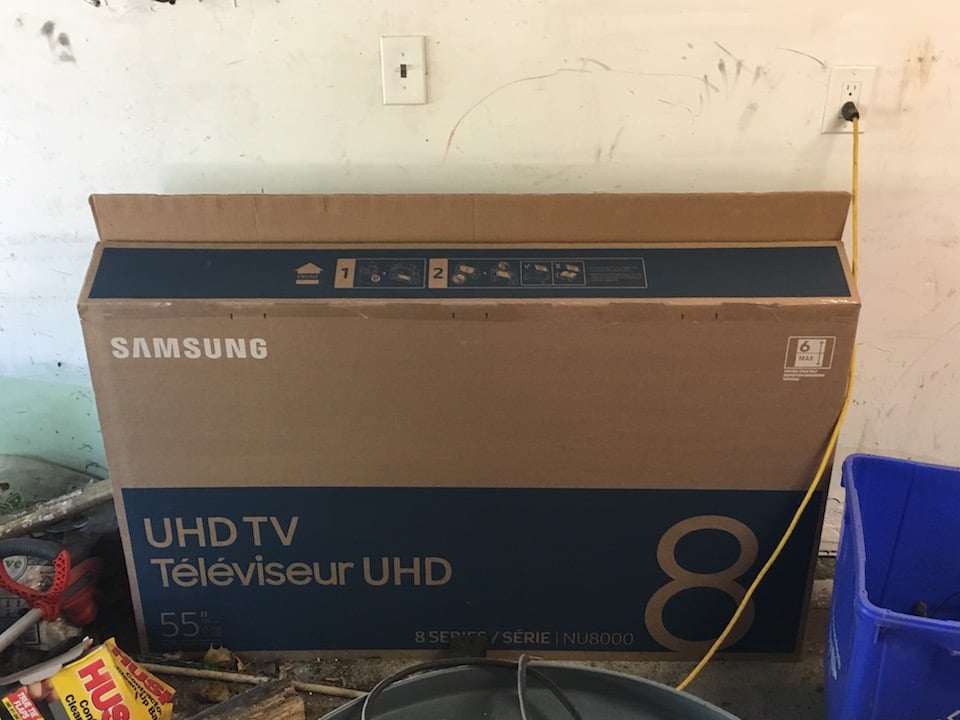
Another staple found in messy garages is old cardboard. Maybe it’s old boxes from Amazon orders or electronics purchases. Some people hold onto moving boxes for years.
The photo above shows a box from a recent TV purchase that was being kept in a garage. The homeowner was holding onto the box in case there were any issues with the TV and it needed to be repaired while still under warranty. While that is a good idea, the box would be better off stored in better conditions indoors for a year.
And if you’re not planning to move within the next few years, there is no reason to keep moving boxes. Even if the cardboard boxes being kept in your garage are all broken down and flattened, there are a few reasons to break this bad habit of keeping cardboard around:
- the space taken up by cardboard that is being held onto “just in case” could be put to better use
- pests are attracted to cardboard, particularly the glue used on the boxes
- moisture and cold temperatures cause cardboard to deteriorate over time
- all of that cardboard collects dust and contributes to a dirtier garage with poor air quality
- a stack of discarded cardboard is just one more thing you have to navigate around or move when cleaning the garage
4. Old books, magazines, and paper items
Like cardboard, any paper-based items being stored in the garage such as books, newspapers, magazines, photos, board games, and documents like old invoices and tax returns become a magnet for rodents and insects.
Keeping these things stored in airtight plastic storage bins to keep out pests and moisture will help, but it’s generally not a good idea to store any paper-related products in the garage for a long time. In addition to the aforementioned reasons, all of that paper becomes a potential fire hazard as well.
And how many of these things are you ever realistically going to read again? Old documents and tax returns have little use to you after a few years. Old newspapers and magazines will be filled with outdated news and information that you can find online anyway.
Let’s face it, those old books you never got around to reading will probably stay unread, especially if they have been sitting in a dusty, moisture-prone environment for years. Photos that are important to you should not be stored in the garage under any circumstances.
Do yourself a favor and lighten your garage’s storage load by donating the books and filling up your recycling bin every week until all of that paper clutter has vanished.
5. Old tires
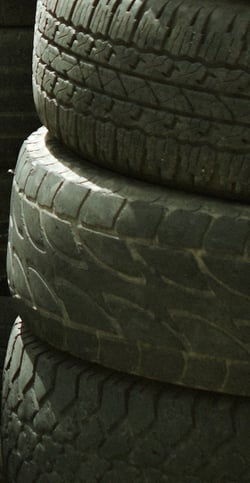 Old car, truck, and bike tires usually end up in the corner of a garage on the floor. You can’t just toss them in the garbage anymore, as tires can be recycled into many different things. Here are some examples:
Old car, truck, and bike tires usually end up in the corner of a garage on the floor. You can’t just toss them in the garbage anymore, as tires can be recycled into many different things. Here are some examples:
- rubberized asphalt
- steel goods
- rubber mulch
- carpeting
- tire-derived fuel
Your local waste recycling center should be able to take your old tires. Another option is to bring them to a tire retailer, who will charge you a small recycling fee.
If you’re keeping old tires stored in the garage for use later, be mindful that they do have a “best before” date. The rubber in tires degrades over time, which is known as tire dry rot or sidewall cracking.
In most cases, if the tires are more than 10 years old (which is about the maximum service life for most vehicle tires), get rid of them.
6. Broken and rusty tools
Broken power tools, rusty garden tools, rakes with missing tines, a rusty hammer or screwdriver…the list of old tools that exist only to take up space in your garage can go on and on.
By now, you’ve probably replaced most of your broken or well-worn tools with something newer. Keeping those old tools around only makes your garage more disorganized because they’re one more thing you have occupying space.
For example, take a rusty old shovel that has been hanging on your garage wall that is rarely or no longer used. Simply getting rid of it doesn’t just create more space for storing something in the future.
It makes it easier to rearrange your storage wall if necessary and also gives you one less thing to scan the wall for when looking for a specific item. The latter may sound like a minor thing, but instantly being able to find a tool in the garage when you need it can add up to hours saved over the course of a couple of years.
7. Exercise equipment that is never used
The garage is an ideal home fitness space if you’re working out regularly. However, if your garage is storing exercise equipment that hasn’t been used in years, that valuable floor space that could be put to better use.
Over a number of years, moisture in the garage can take a toll on different types of fitness machines and equipment. Weight benches, metal weights, and metal parts on exercise machines may rust.
Temperature fluctuations will put extra stress on the plastic and metal in exercise equipment, causing it to expand and contract. A simple lack of use often leads to performance issues with anything that has a lot of moving parts like a treadmill.
At the very least, all of these factors will contribute to any unused exercise equipment being stored in the garage having a shorter life.
If regular workouts just aren’t in your foreseeable future, clear out that equipment to create more useful garage storage space.
8. Leftover building materials
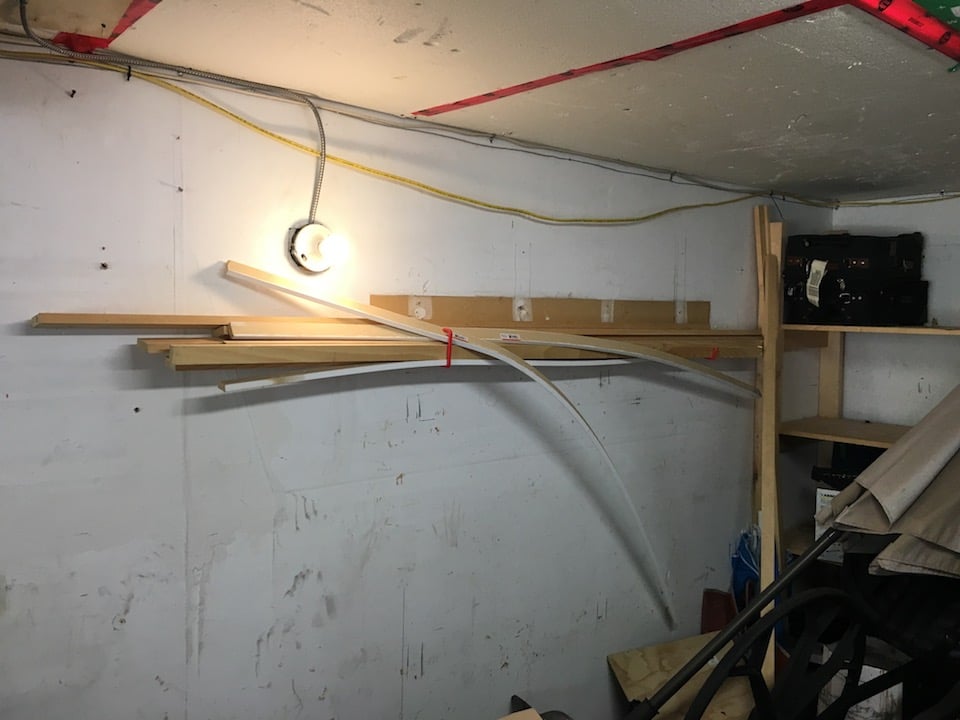
Keeping a few extra pieces of scrap wood around for a home repair or some extra paver stones to replaced damaged stones can come in handy and save you a trip to the home improvement store.
The problem with a lot of garages is that they end up becoming a storage space for far more leftover building material products than will ever get used. They are often stored haphazardly, such as the scrap wood pictured above.
Boxes of ceramic tiles that get moved or have items stored on top of them will end up with damaged tile pieces. The dampness and temperature changes in garages won’t treat any leftover hardwood flooring you have stored there kindly. And remember, cardboard packaging for building materials stored in the garage for lengthy periods is susceptible to the issues already mentioned.
Whether it’s leftovers from a remodel or a hobby project whose progress hit the proverbial brick wall, this garage junk cleaning time is a great opportunity to toss a lot of those old building material products you’ll never use.
9. Hazardous waste
It’s estimated that the average garage contains approximately 100 pounds of hazardous waste.
In addition to old paint, the average garage houses all sorts of hazardous products that accumulate over time like stains, varnishes, caulking tubes, car cleaning and maintenance products, lawn and garden fertilizers, and general household cleaners.
Some of these items have expiry dates and those that don’t typically have a shelf life of only a few years. Keeping chemicals and hazardous products stored for long periods in environments where temperature conditions aren’t optimal shortens their shelf life and makes them less effective when used.
All of these things that have limited or no use aren’t just taking up space, they are also an ingestion and flammable hazard.
10. Old appliances, electronics, and outdated media
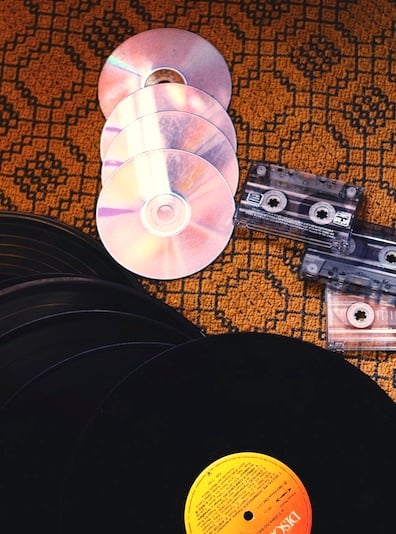 Outdated media and the devices to play them on may be stored in your garage. Now is the time to finally ditch all of those obsolete electronics and media that just can’t compete with today’s smart devices and streaming technology.
Outdated media and the devices to play them on may be stored in your garage. Now is the time to finally ditch all of those obsolete electronics and media that just can’t compete with today’s smart devices and streaming technology.
We hate to sound like a broken record (pun intended), but because vinyl records, CDs, cassettes, and VHS tapes all have paper packaging and liner notes, you know by now how they’ll fare with long-term garage storage.
Being kept in a storage space with moisture and changing temperatures will often cause playback issues with these different types of media, too.
Old VCRs, DVD players, CD players, cassette decks, computers and peripheral devices, turntables, receivers, TVs, and maybe even an ancient 8-track tape player should be brought to your local electronics recycling facility or donated if they still work.
Some charities may take donations of your old media, depending on the format. Well-preserved vinyl records, which have seen a revival in the past decade or so, will certainly generate the most interest.
Get rid of any old appliances like a fridge or window air conditioning unit that don’t work. Small appliances that never got used and ended up in the garage should also be joining your junk exodus.
Maybe you bought something like a juicer or slow cooker and simply never got around to using them (you wouldn’t be the first), or you received them as a gift. If they are still clean, in their original packaging, and actually work, a charity will certainly take them off your hands.
11. Old furniture
Deal with any discarded furniture you come across while garage junk cleaning. Things like an old sofa, bookcase, tables, and chairs are taking up more space than they should.
It could be that you planned to reupholster or restain one of your old furniture pieces and were unable to find the time to do so.
Unfortunately, soft furnishings that weren’t properly covered will have years of dust, dirt, grime, and absorbed car fumes for you to contend with if you wanted to salvage them.
Wood furniture (meaning most furniture) also attracts those darn pests and will warp in damp environments where there are significant temperature changes.
This is one reason repurposing old kitchen cabinets and bookcases for garage storage isn’t a good idea. Aside from the fact that were meant for a heated living space, these storage systems also look out of place in a garage and detract from the room’s appearance. A much better solution is to invest in a proper garage storage cabinet system.
Don’t forget to toss out any pieces of old patio furniture that have seen better days, especially if you have replaced the pieces with newer models.
12. Clothes that have been in long-term storage
Another way to create more space in the garage is to remove any boxes or plastic storage bins that contain clothes or any textile products.
Moisture and pests are the two main enemies of textiles that are stored in a garage space for long periods. Exhaust fumes and dust will cause additional problems if clothing hasn’t been stored in airtight containers.
In general, try to avoid storing any textiles in the garage. Keep your extra clothes and seasonal clothes stored somewhere in your home that is climate-controlled and safe from pests.
Some organizing professionals even recommend storing your more fragile fabric holiday decorations in a space other than the garage.
And if you have a bunch of boxes or storage bins filled with clothes in the garage, ask yourself – how much of this stuff does my family really need? Take this cleaning time to figure out which clothing items can be donated.
13. Old and broken lawn and garden supplies
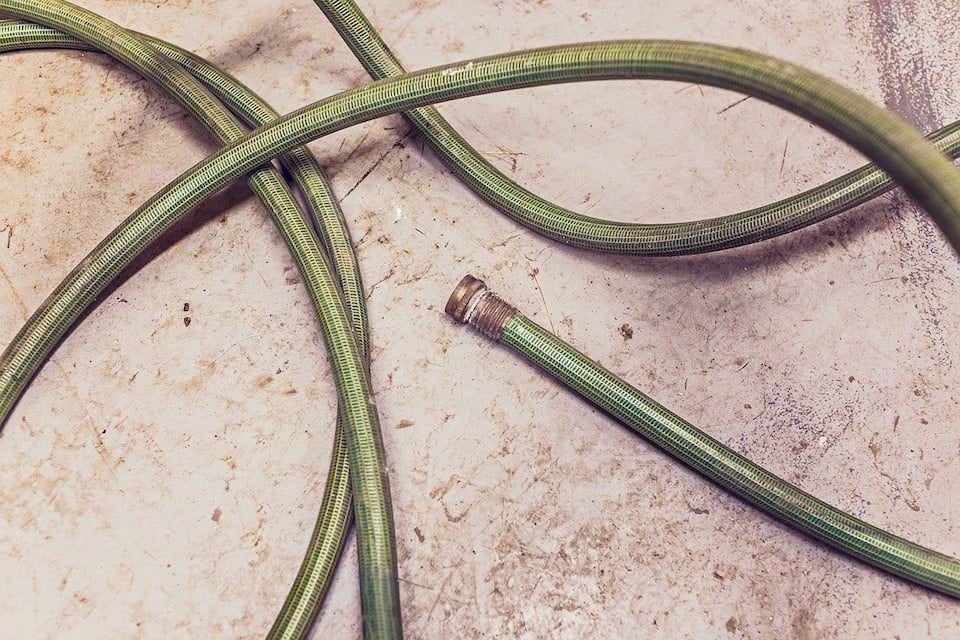
Lawn and garden supplies that break, get worn out, or just don’t work very well anymore can likely be found scattered throughout any cluttered garage.
Round up that split or leaky garden hose, cracked hose reel, old sprinkler, ripped or orphaned gardening gloves, and those unreliable watering accessories and just toss them out.
Do the same with any ceramic, clay, and plastic pots that are damaged and no longer useful. Look for plastic planter trays and paper fiber pots you’ve accumulated over the years as well.
Depending on where you live, some of your old plastic gardening products can simply be added to your recycling bins.
14. Old kids toys
Sports equipment and clothes for kids have a fairly short life because they outgrow these things so quickly. They’ll outgrow their toys, too, or eventually lose interest in them as they age.
If you never got around to donating your kids’ old toys or passing them down to a family member, neighbor, or co-worker, it’s probably the basement or garage where they ended up.
Do what you can to give kids toys that are in still good shape and safe to play with another home.
Unfortunately, broken toys will have to end up in a landfill since most of the plastics used in them is too difficult to recycle.
15. Any remaining items
We have now covered most of what you will dealing with when undertaking a garage junk cleaning project. But because garages are so large and typically a home’s go-to spot for dumping things, there may be even more items you encounter while cleaning up.
Here are some additional things to look for when decluttering the garage:
- items you never got around to fixing and likely never will
- boxes or plastic storage bins with broken holiday decorations
- old luggage
- old strollers, toddler car seats, and baby accessories
- camping equipment that is damaged or never used
- firewood (which should not be stored in the garage)
Take the next step after your garage junk cleaning project
Congratulations! By getting rid of this junk, you’ve taken that all-important first step towards reclaiming your garage’s functionality.
Now take the next step.
Garage Living can transform your unfinished, outdated garage into an attractive and modern extension of your living space.
We’ll also outfit your garage with durable, high-quality storage systems that make it easier to keep the garage organized and running efficiently on a daily basis.
Schedule a free design consultation with us to start taking full advantage of what your garage can do for your home and family.
Please share this post if you found it useful.